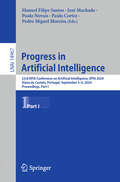 Progress in Artificial Intelligence: 23rd EPIA Conference on Artificial Intelligence, EPIA 2024, Viana do Castelo, Portugal, September 3–6, 2024, Proceedings, Part I (Lecture Notes in Computer Science #14967)
6347334
Progress in Artificial Intelligence: 23rd EPIA Conference on Artificial Intelligence, EPIA 2024, Viana do Castelo, Portugal, September 3–6, 2024, Proceedings, Part I (Lecture Notes in Computer Science #14967)
6347334
|
Paulo Cortez
Paulo Novais
José Machado
Manuel Filipe Santos
Pedro Miguel Moreira
|
9783031734977 |
2025 |
Contains images
|
|
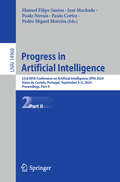 Progress in Artificial Intelligence: 23rd EPIA Conference on Artificial Intelligence, EPIA 2024, Viana do Castelo, Portugal, September 3–6, 2024, Proceedings, Part II (Lecture Notes in Computer Science #14968)
6494037
Progress in Artificial Intelligence: 23rd EPIA Conference on Artificial Intelligence, EPIA 2024, Viana do Castelo, Portugal, September 3–6, 2024, Proceedings, Part II (Lecture Notes in Computer Science #14968)
6494037
|
Paulo Cortez
Paulo Novais
José Machado
Manuel Filipe Santos
Pedro Miguel Moreira
|
9783031735004 |
2025 |
Contains images
|
|
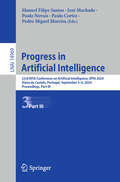 Progress in Artificial Intelligence: 23rd EPIA Conference on Artificial Intelligence, EPIA 2024, Viana do Castelo, Portugal, September 3–6, 2024, Proceedings, Part III (Lecture Notes in Computer Science #14969)
6347332
Progress in Artificial Intelligence: 23rd EPIA Conference on Artificial Intelligence, EPIA 2024, Viana do Castelo, Portugal, September 3–6, 2024, Proceedings, Part III (Lecture Notes in Computer Science #14969)
6347332
|
Paulo Cortez
Paulo Novais
José Machado
Manuel Filipe Santos
Pedro Miguel Moreira
|
9783031735035 |
2025 |
Contains images
|
|
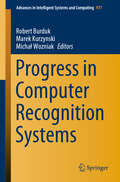 Progress in Computer Recognition Systems (Advances in Intelligent Systems and Computing #977)
2572425
Progress in Computer Recognition Systems (Advances in Intelligent Systems and Computing #977)
2572425
|
Robert Burduk
Marek Kurzynski
Michał Wozniak
|
9783030197384 |
2019 |
Contains images
|
|
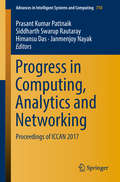 Progress in Computing, Analytics and Networking: Proceedings Of Iccan 2017 (Advances In Intelligent Systems And Computing #710)
2281278
Progress in Computing, Analytics and Networking: Proceedings Of Iccan 2017 (Advances In Intelligent Systems And Computing #710)
2281278
|
Prasant Kumar Pattnaik
Himansu Das
Siddharth Swarup Rautaray
Janmenjoy Nayak
|
9789811078712 |
2018 |
Contains images
|
|
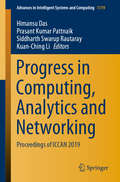 Progress in Computing, Analytics and Networking: Proceedings of ICCAN 2019 (Advances in Intelligent Systems and Computing #1119)
3405605
Progress in Computing, Analytics and Networking: Proceedings of ICCAN 2019 (Advances in Intelligent Systems and Computing #1119)
3405605
|
Kuan-Ching Li
Prasant Kumar Pattnaik
Himansu Das
Siddharth Swarup Rautaray
|
9789811524141 |
2020 |
Contains images
|
|
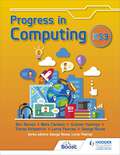 Progress in Computing: Key Stage 3
4105052
Progress in Computing: Key Stage 3
4105052
|
George Rouse
Lorne Pearcey
Ben Barnes
Tristan Kirkpatrick
Graham Hastings
Mark Clarkson
|
9781398322301 |
2021 |
Contains images
|
|
 Progress in Computing: Key Stage 3
4305654
Progress in Computing: Key Stage 3
4305654
|
George Rouse
Lorne Pearcey
Ben Barnes
Tristan Kirkpatrick
Graham Hastings
Mark Clarkson
|
9781398322301 |
2021 |
Contains images
|
|
 Progress in Cryptology - AFRICACRYPT 2020: 12th International Conference on Cryptology in Africa, Cairo, Egypt, July 20 – 22, 2020, Proceedings (Lecture Notes in Computer Science #12174)
3547322
Progress in Cryptology - AFRICACRYPT 2020: 12th International Conference on Cryptology in Africa, Cairo, Egypt, July 20 – 22, 2020, Proceedings (Lecture Notes in Computer Science #12174)
3547322
|
Abderrahmane Nitaj
Amr Youssef
|
9783030519384 |
2020 |
Contains images
|
|
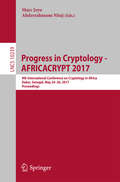 Progress in Cryptology - AFRICACRYPT 2017: 9th International Conference on Cryptology in Africa, Dakar, Senegal, May 24-26, 2017, Proceedings (Lecture Notes in Computer Science #10239)
5923602
Progress in Cryptology - AFRICACRYPT 2017: 9th International Conference on Cryptology in Africa, Dakar, Senegal, May 24-26, 2017, Proceedings (Lecture Notes in Computer Science #10239)
5923602
|
Marc Joye and Abderrahmane Nitaj
|
9783319573397 |
2017 |
Contains images
|
|
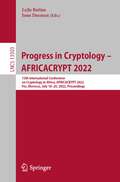 Progress in Cryptology - AFRICACRYPT 2022: 13th International Conference on Cryptology in Africa, AFRICACRYPT 2022, Fes, Morocco, July 18–20, 2022, Proceedings (Lecture Notes in Computer Science #13503)
4957953
Progress in Cryptology - AFRICACRYPT 2022: 13th International Conference on Cryptology in Africa, AFRICACRYPT 2022, Fes, Morocco, July 18–20, 2022, Proceedings (Lecture Notes in Computer Science #13503)
4957953
|
Lejla Batina
Joan Daemen
|
9783031174339 |
2022 |
Contains images
|
|
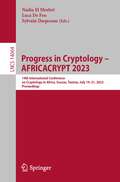 Progress in Cryptology - AFRICACRYPT 2023: 14th International Conference on Cryptology in Africa, Sousse, Tunisia, July 19–21, 2023, Proceedings (Lecture Notes in Computer Science #14064)
5455743
Progress in Cryptology - AFRICACRYPT 2023: 14th International Conference on Cryptology in Africa, Sousse, Tunisia, July 19–21, 2023, Proceedings (Lecture Notes in Computer Science #14064)
5455743
|
Sylvain Duquesne
Nadia El Mrabet
Luca De Feo
|
9783031376795 |
2023 |
Contains images
|
|
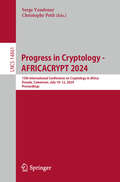 Progress in Cryptology - AFRICACRYPT 2024: 15th International Conference on Cryptology in Africa, Douala, Cameroon, July 10–12, 2024, Proceedings (Lecture Notes in Computer Science #14861)
6117180
Progress in Cryptology - AFRICACRYPT 2024: 15th International Conference on Cryptology in Africa, Douala, Cameroon, July 10–12, 2024, Proceedings (Lecture Notes in Computer Science #14861)
6117180
|
Christophe Petit
Serge Vaudenay
|
9783031643811 |
2024 |
Contains images
|
|
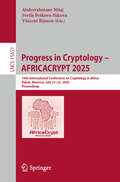 Progress in Cryptology - AFRICACRYPT 2025: 16th International Conference on Cryptology in Africa, Rabat, Morocco, July 21–23, 2025, Proceedings (Lecture Notes in Computer Science #15651)
6666196
Progress in Cryptology - AFRICACRYPT 2025: 16th International Conference on Cryptology in Africa, Rabat, Morocco, July 21–23, 2025, Proceedings (Lecture Notes in Computer Science #15651)
6666196
|
Abderrahmane Nitaj
Svetla Petkova-Nikova
Vincent Rijmen
|
9783031972607 |
2026 |
Contains images
|
|
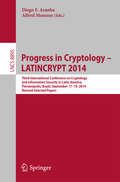 Progress in Cryptology - LATINCRYPT 2014
1419966
Progress in Cryptology - LATINCRYPT 2014
1419966
|
Diego F. Aranha
Alfred Menezes
|
9783319162959 |
2015 |
Contains images
|
|
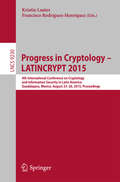 Progress in Cryptology -- LATINCRYPT 2015
1416045
Progress in Cryptology -- LATINCRYPT 2015
1416045
|
Kristin Lauter
Francisco Rodríguez-Henríquez
|
9783319221748 |
2015 |
Contains images
|
|
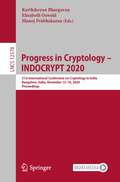 Progress in Cryptology – INDOCRYPT 2020: 21st International Conference on Cryptology in India, Bangalore, India, December 13–16, 2020, Proceedings (Lecture Notes in Computer Science #12578)
3939700
Progress in Cryptology – INDOCRYPT 2020: 21st International Conference on Cryptology in India, Bangalore, India, December 13–16, 2020, Proceedings (Lecture Notes in Computer Science #12578)
3939700
|
Elisabeth Oswald
Karthikeyan Bhargavan
Manoj Prabhakaran
|
9783030652777 |
2020 |
Contains images
|
|
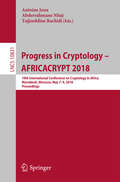 Progress in Cryptology – AFRICACRYPT 2018: 10th International Conference On Crytology In Africa, Marrakesh, Morocco, May 7-9, 2018, Proceedings (Lecture Notes in Computer Science #10831)
2013978
Progress in Cryptology – AFRICACRYPT 2018: 10th International Conference On Crytology In Africa, Marrakesh, Morocco, May 7-9, 2018, Proceedings (Lecture Notes in Computer Science #10831)
2013978
|
Abderrahmane Nitaj
Tajjeeddine Rachidi
Antoine Joux
|
9783319893396 |
2018 |
Contains images
|
|
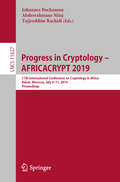 Progress in Cryptology – AFRICACRYPT 2019: 11th International Conference on Cryptology in Africa, Rabat, Morocco, July 9–11, 2019, Proceedings (Lecture Notes in Computer Science #11627)
5925347
Progress in Cryptology – AFRICACRYPT 2019: 11th International Conference on Cryptology in Africa, Rabat, Morocco, July 9–11, 2019, Proceedings (Lecture Notes in Computer Science #11627)
5925347
|
Johannes Buchmann
Abderrahmane Nitaj
Tajjeeddine Rachidi
|
9783030236960 |
2019 |
Contains images
|
|
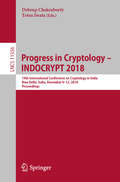 Progress in Cryptology – INDOCRYPT 2018: 19th International Conference on Cryptology in India, New Delhi, India, December 9–12, 2018, Proceedings (Lecture Notes in Computer Science #11356)
5919791
Progress in Cryptology – INDOCRYPT 2018: 19th International Conference on Cryptology in India, New Delhi, India, December 9–12, 2018, Proceedings (Lecture Notes in Computer Science #11356)
5919791
|
Tetsu Iwata
Debrup Chakraborty
|
9783030053789 |
2018 |
Contains images
|
|
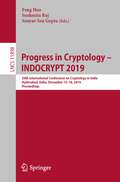 Progress in Cryptology – INDOCRYPT 2019: 20th International Conference on Cryptology in India, Hyderabad, India, December 15–18, 2019, Proceedings (Lecture Notes in Computer Science #11898)
5920482
Progress in Cryptology – INDOCRYPT 2019: 20th International Conference on Cryptology in India, Hyderabad, India, December 15–18, 2019, Proceedings (Lecture Notes in Computer Science #11898)
5920482
|
Feng Hao
Sushmita Ruj
Sourav Sen Gupta
|
9783030354237 |
2019 |
Contains images
|
|
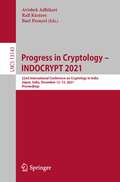 Progress in Cryptology – INDOCRYPT 2021: 22nd International Conference on Cryptology in India, Jaipur, India, December 12–15, 2021, Proceedings (Lecture Notes in Computer Science #13143)
5926497
Progress in Cryptology – INDOCRYPT 2021: 22nd International Conference on Cryptology in India, Jaipur, India, December 12–15, 2021, Proceedings (Lecture Notes in Computer Science #13143)
5926497
|
Bart Preneel
Avishek Adhikari
Ralf Küsters
|
9783030925185 |
2021 |
Contains images
|
|
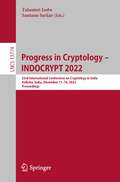 Progress in Cryptology – INDOCRYPT 2022: 23rd International Conference on Cryptology in India, Kolkata, India, December 11–14, 2022, Proceedings (Lecture Notes in Computer Science #13774)
5162953
Progress in Cryptology – INDOCRYPT 2022: 23rd International Conference on Cryptology in India, Kolkata, India, December 11–14, 2022, Proceedings (Lecture Notes in Computer Science #13774)
5162953
|
Takanori Isobe
Santanu Sarkar
|
9783031229121 |
2022 |
Contains images
|
|
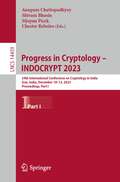 Progress in Cryptology – INDOCRYPT 2023: 24th International Conference on Cryptology in India, Goa, India, December 10–13, 2023, Proceedings, Part I (Lecture Notes in Computer Science #14459)
5948555
Progress in Cryptology – INDOCRYPT 2023: 24th International Conference on Cryptology in India, Goa, India, December 10–13, 2023, Proceedings, Part I (Lecture Notes in Computer Science #14459)
5948555
|
Chester Rebeiro
Anupam Chattopadhyay
Shivam Bhasin
Stjepan Picek
|
9783031562327 |
2024 |
Contains images
|
|
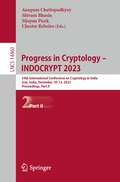 Progress in Cryptology – INDOCRYPT 2023: 24th International Conference on Cryptology in India, Goa, India, December 10–13, 2023, Proceedings, Part II (Lecture Notes in Computer Science #14460)
5948697
Progress in Cryptology – INDOCRYPT 2023: 24th International Conference on Cryptology in India, Goa, India, December 10–13, 2023, Proceedings, Part II (Lecture Notes in Computer Science #14460)
5948697
|
Chester Rebeiro
Anupam Chattopadhyay
Shivam Bhasin
Stjepan Picek
|
9783031562358 |
2024 |
Contains images
|
|